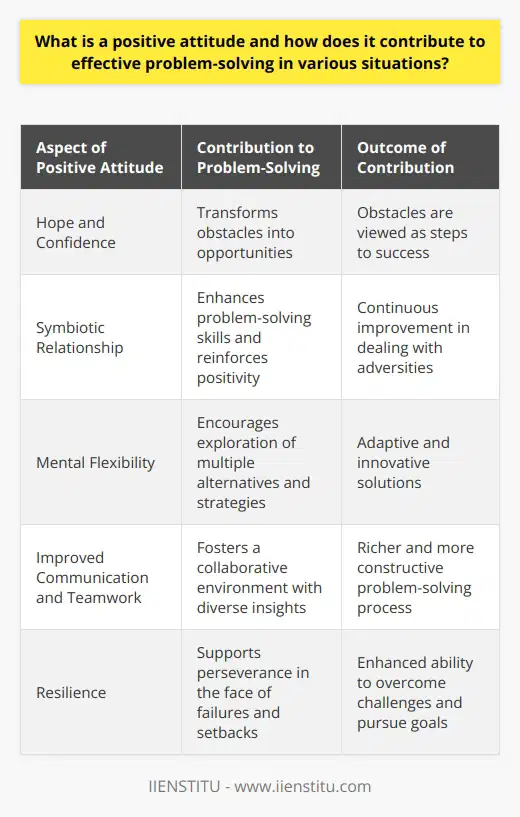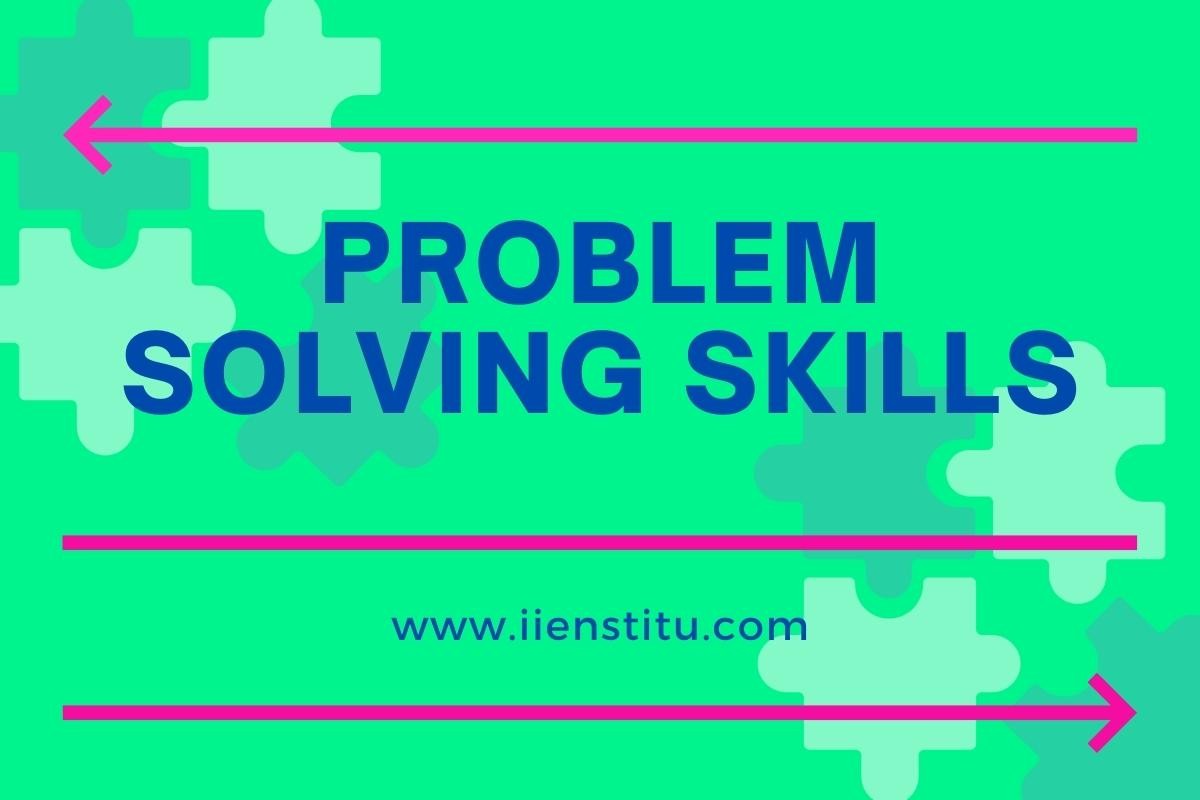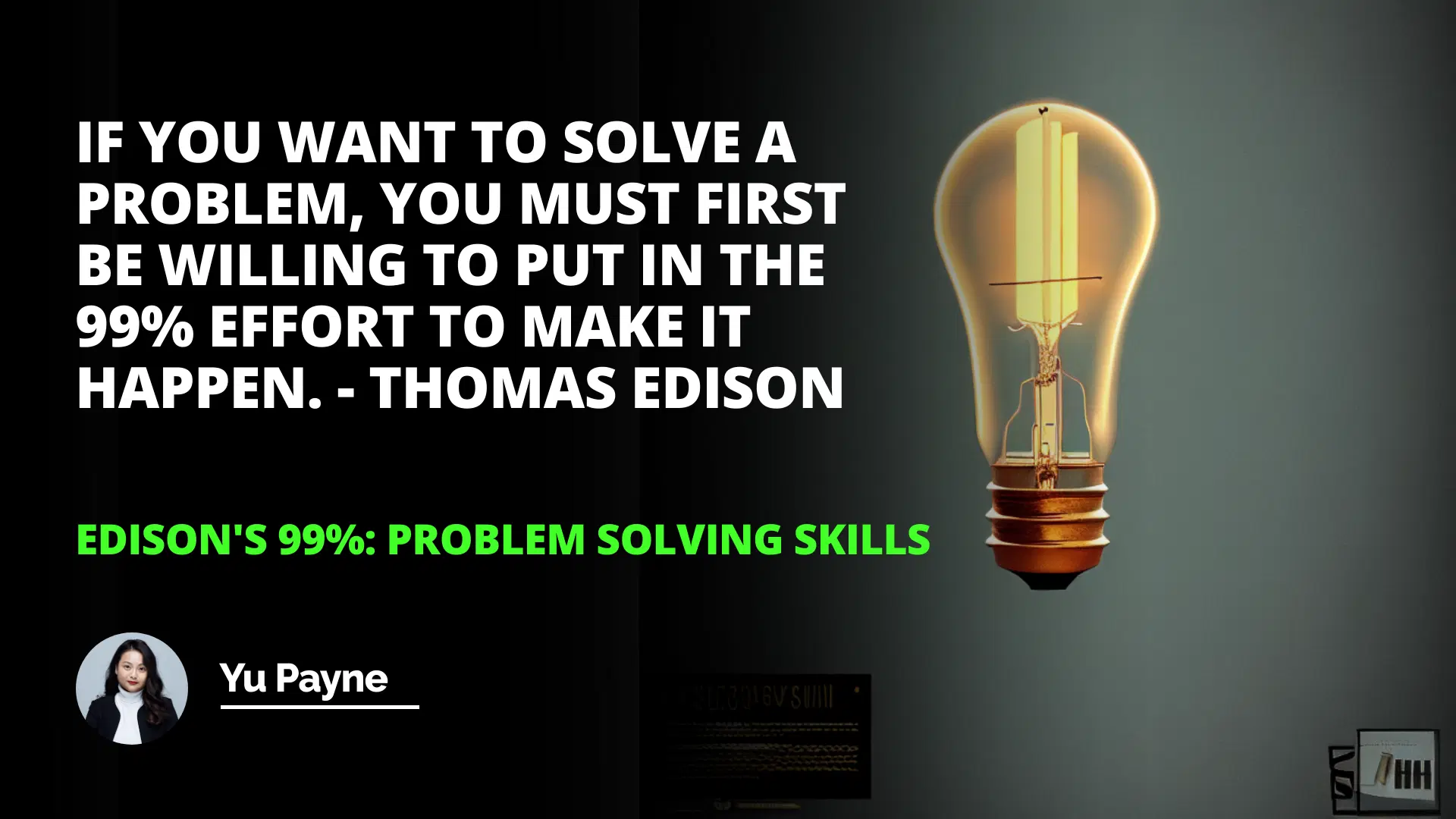
This article explores the life and work of Thomas Edison, one of the most famous inventors of all time. Edison's success was due to a combination of inspiration and hard work, such as setting himself a quota of one minor invention every ten days and keeping meticulous notebooks to keep track of all his ideas. His approach to the invention has been studied and admired by many, and his legacy will continue to inspire inventors for generations to come.
Introduction
Edison's Inspiration
Edison's Work Habits
Edison's Notebooks
Conclusion
Introduction: Thomas Edison is one of the most famous inventors of all time, having earned over a thousand patents and starting several businesses based on his inventions. His success was the result of a combination of inspiration and hard work, and his way of thinking and approach to the invention have been studied and discussed by many. This article will explore Edison's inspiration, work habits, and notebooks and analyze how these elements contributed to his success as an inventor.
Edison's Inspiration
Edison famously stated that invention was one percent inspiration and ninety-nine percent perspiration, and he followed his advice. He was constantly looking for new ideas and pushing himself to come up with more and more. He set himself a quota of one minor invention every ten days and a major invention every six months, and he relentlessly pushed himself to meet these goals. He also challenged assumptions and pushed the boundaries of the state-of-the-art.
Edison's Work Habits
Edison's work habits were legendary. He worked seven days a week, often for long hours, and was meticulous in keeping notebooks to keep track of all his ideas. He was also a great believer in the power of experimentation. It is said that it took him over 50,000 experiments to invent the alkaline storage cell battery and 9,000 to perfect the lightbulb.
Edison's Notebooks
Edison's notebooks were a crucial part of his invention process. He kept detailed notes on all his experiments, allowing him to review ideas and refine them. He also kept records of his successes and failures, which allowed him to learn from his mistakes and make adjustments for future experiments.
Conclusion: Thomas Edison was a genius inventor who combined inspiration and hard work to create some of the most famous inventions in history. His work habits, such as setting himself a quota and keeping meticulous notebooks, were essential to his success. His notebooks were essential, as they allowed him to keep track of all his ideas and experiments and to learn from his successes and failures. Edison's approach to the invention has been studied and admired by many, and his legacy will continue to inspire inventors for generations to come.
If you want to solve a problem, you must first be willing to put in 99% effort to make it happen. - Thomas Edison
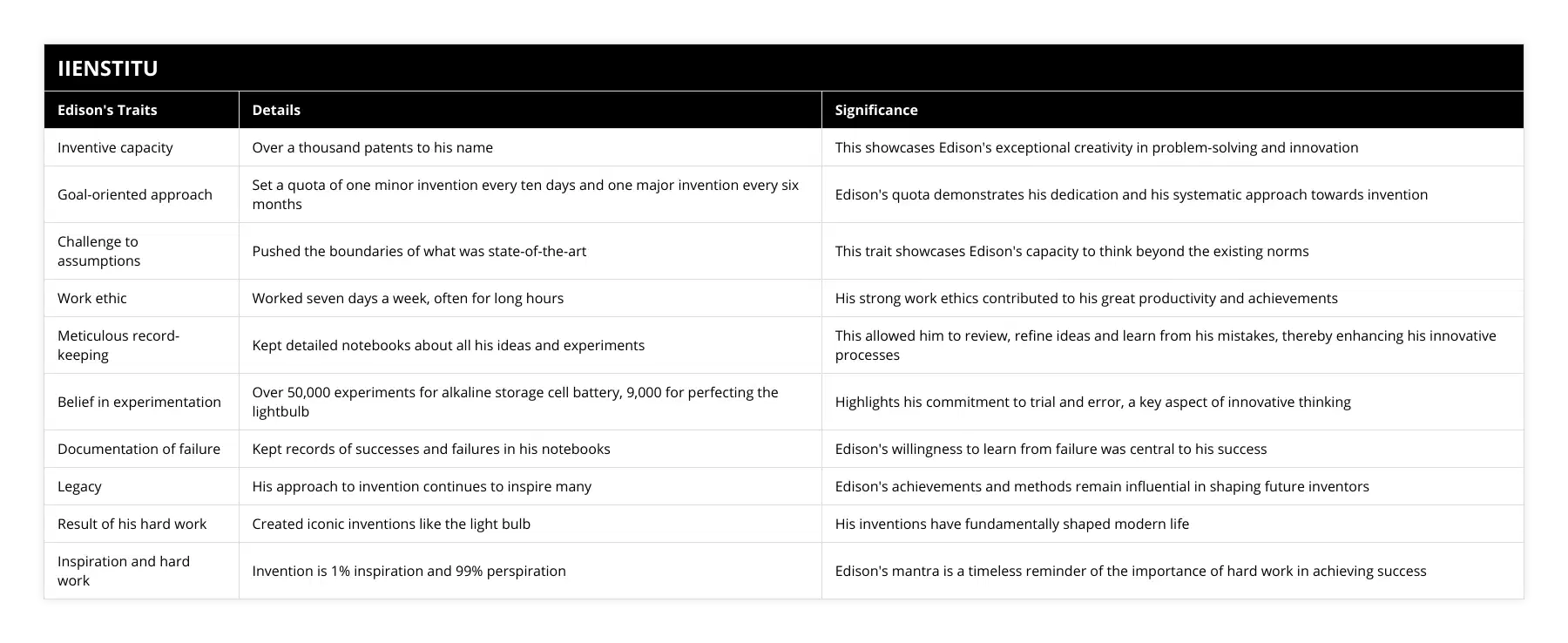
Frequently Asked Questions
What inspired Thomas Edison to develop his problem-solving skills?
Thomas Edison is recognized as one of the most successful inventors and scientists. He is best known for his contributions to developing the electric light bulb, the phonograph, and motion pictures. His success in these fields is attributed to his problem-solving skills, which allowed him to identify and solve challenges while developing his inventions. But what inspired Edison to develop these skills
Throughout Edison’s life, he was constantly exposed to new ideas and inventions, which motivated him to explore and understand complex problems. His education exposed him to science and technology, which provided him with the foundational knowledge and skills to tackle technological problems. He was also inspired by the works of other inventors, such as Alexander Graham Bell, who had developed revolutionary inventions and technologies.
Edison’s curiosity and willingness to explore new ideas further inspired him to develop his problem-solving skills. He was constantly experimenting, tinkering, and building things in his laboratory, which allowed him to develop an understanding of how things work. His passion and enthusiasm for his work motivated him to continue learning and developing his problem-solving skills.
The development of Edison’s problem-solving skills was also inspired by his desire to improve the lives of others. He saw the potential of his inventions to make life easier, which motivated him to find solutions to complex problems. He believed in the power of innovation to improve the world, which gave him the inspiration to continue developing his problem-solving skills.
In conclusion, Thomas Edison’s problem-solving skills were inspired by his eagerness to learn and explore new ideas, his passion and enthusiasm for his work, and his desire to improve the lives of others. His example has inspired countless inventors and scientists to follow in his footsteps and use their problem-solving skills to create innovative solutions.
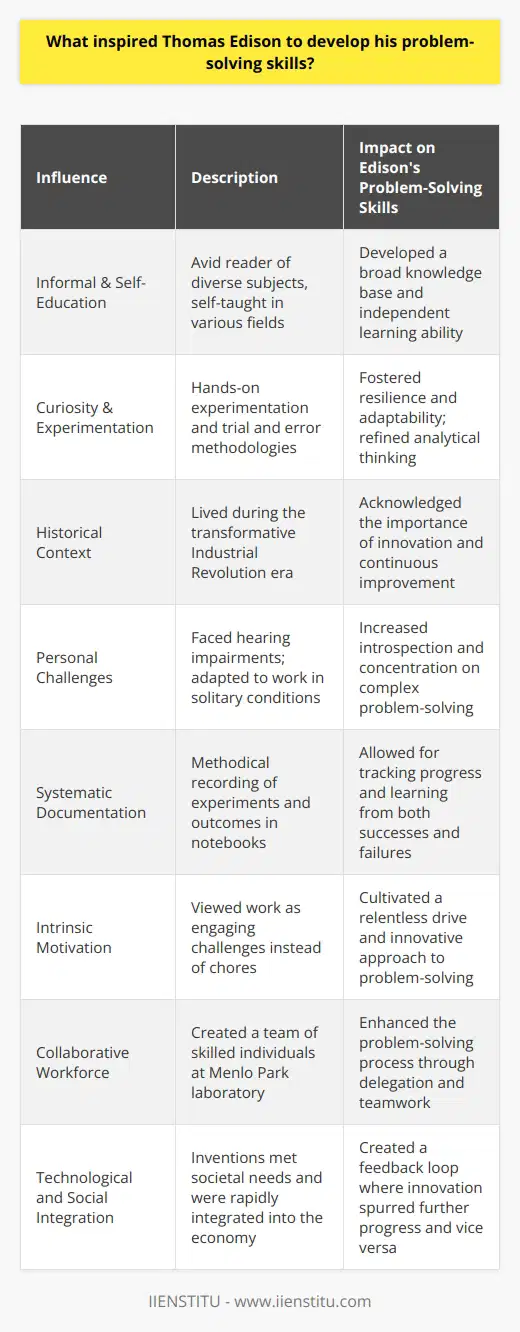
How did Edison use his notebooks to help him solve problems?
Thomas Edison, one of the most prolific inventors of all time, was known for his use of notebooks to help him solve problems. He used the notebooks as a tool for organizing his thoughts and helping him to focus on the details of whatever invention he was working on. The notebooks served as a repository for Edison's ideas and insights, enabling him to access the information he needed when he needed it quickly.
Edison kept notebooks on various topics, but the ones he most commonly used to help him solve problems were those devoted to electrical experiments. He would use the notebooks to record his observations and experiments and note down any ideas he had.
This enabled him to track his progress and review the data he had gathered to understand better the problem he was trying to solve. He would also use notebooks to identify patterns and draw conclusions from his experiments, which helped him to narrow down the possible causes of a problem and to determine the best solution.
In addition to tracking experiments and observations, Edison used his notebooks to document the results of his problem-solving efforts. He would note down any solutions he found and any changes he made to his designs, which allowed him to track his progress over time and see how his efforts were paying off.
Finally, Edison used his notebooks to record the details of his inventions and processes. This enabled him to quickly access the information he needed to troubleshoot problems or to make changes to his designs. Edison's notebooks were an invaluable tool for him, as they provided him with a comprehensive record of his work that he could refer to when he needed to solve a problem.
In summary, Edison used his notebooks to help him solve problems in several ways. He used them to record his experiments and observations, to document the results of his problem-solving efforts, and to store the details of his inventions and processes. The notebooks served as a valuable tool for Edison, enabling him to understand better the problems he was trying to solve and to quickly access the information he needed to make changes to his designs.
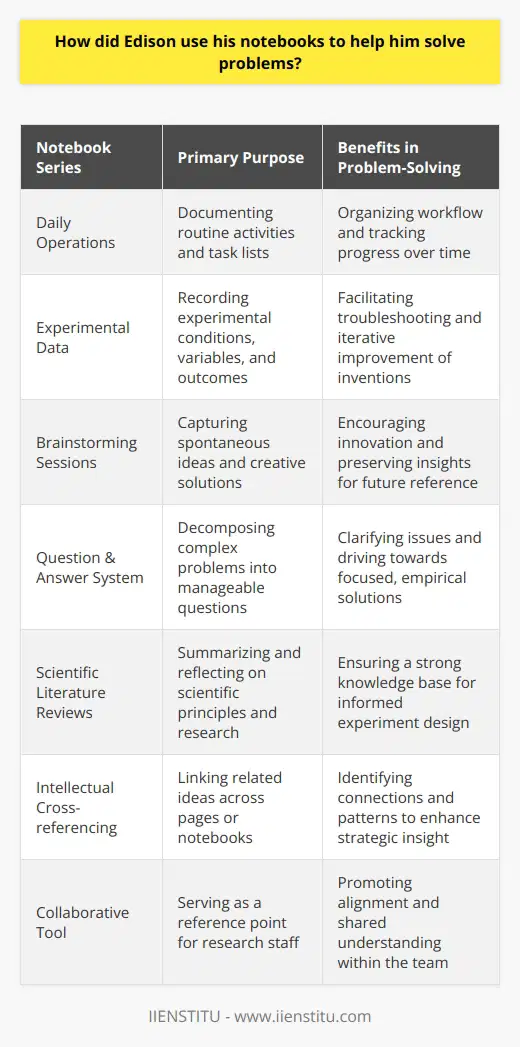
What work habits did Edison employ to help him develop his problem-solving skills?
Thomas Alva Edison is considered one of the most influential inventors. His inventions, such as the light bulb, phonograph, and motion picture projector, revolutionized many industries.
Edison was well-known for his exceptional problem-solving skills and developed many inventions through hard work, focus, and dedication. To better understand how Edison developed his problem-solving skills, it is important to examine the work habits he employed.
First, Edison was a hard worker. He worked long hours and was known to work up to 18 hours daily. His work ethic was so intense that he was often referred to as the “Wizard of Menlo Park”. He was also eager to learn and constantly studied to stay informed on the latest technological developments.
Second, Edison was a master of focus. He was able to concentrate intensely on tasks and was able to remain focused for long periods. He was known to take breaks from his work, but even during these short pauses, he could keep his thoughts on the task. He could also filter out distractions and stay focused on the task.
Third, Edison was highly dedicated to his work. He was known to work through the night to perfect his inventions, and he often refused to take breaks or vacations until he had achieved his desired results. He was also willing to take risks and experiment with ideas, even if they seemed unlikely to succeed.
Finally, Edison was a master of trial and error. He was willing to test out different ideas and methods to try and find a solution to a problem. He was also not afraid of failure and was willing to accept mistakes and move on to the next idea. Edison was also willing to take advice from others and incorporate their ideas into his own work.
In conclusion, Thomas Alva Edison was a master problem solver and employed a combination of hard work, focus, dedication, and trial and error to develop his inventions. His dedication to his work and willingness to experiment with ideas and take risks is an inspiration to inventors and entrepreneurs worldwide.
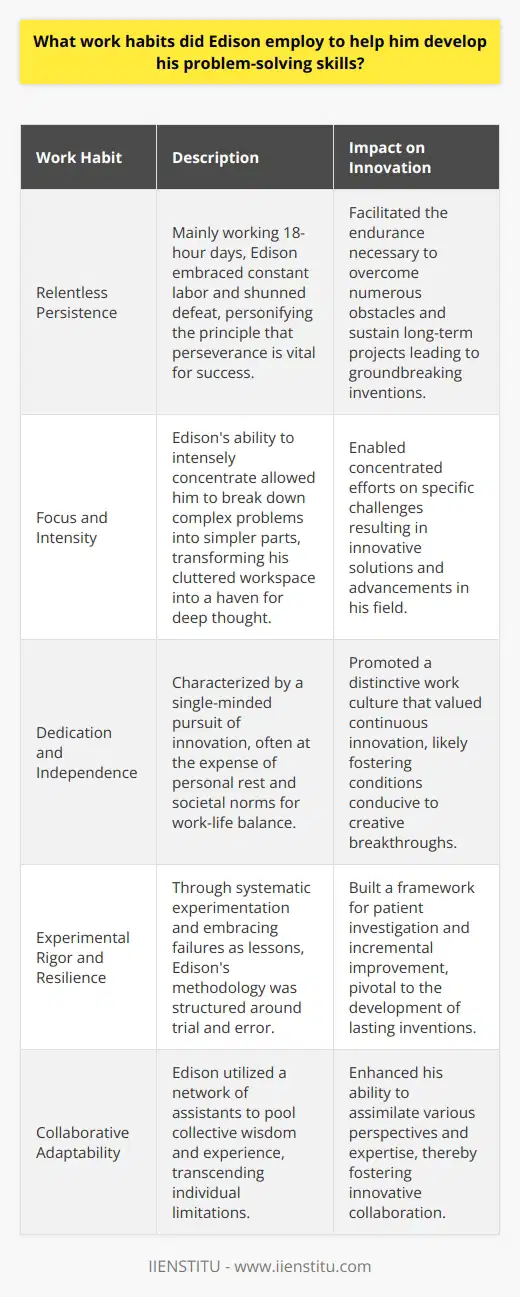
How did Edison's persistence contribute to his ability to solve problems?
Persistence as a Key Factor in Edison's Success
The role of persistence in Thomas Edison's ability to solve problems cannot be understated, as it was an essential element in his numerous innovative solutions and inventions. Edison's unwavering determination enabled him to face multiple obstacles and setbacks during his experimentation process without discouragement.
Overcoming Failures and Setbacks
Throughout Edison's career, his persistence contributed to his ability to learn from failures and mistakes, instead of allowing them to deter his progress. For instance, when inventing the light bulb, he is known to have tried over a thousand materials before discovering a suitable filament. This relentless pursuit of knowledge allowed him to uncover novel solutions that may have remained elusive to others who lacked such tenacity. Edison's famous quote, 'I have not failed. I've just found 10,000 ways that won't work,' aptly demonstrates his unwavering persistence in problem-solving.
Nurturing a Strong Work Ethic
Edison's persistence also manifested itself in the form of a solid work ethic. He was known to work for long hours on his experiments and was entirely dedicated to achieving his goals. This commitment was a cornerstone of his problem-solving abilities, as it afforded him the necessary time and resources to comprehensively study issues and develop innovative solutions. His strong work ethic is often credited as a significant factor in his astounding accomplishments.
Perseverance: the Key to Innovation
Moreover, Edison's persistence embodied his unwavering belief in his own capabilities and the feasibility of his ideas. Despite encountering numerous naysayers and critics over the course of his career, he maintained an unshakable conviction in his innovative potential. Such confidence and belief in oneself are crucial in overcoming self-doubt and the disparagement of others – two obstacles that often hinder productivity and problem-solving abilities.
Adaptive Application of Novel Ideas
Lastly, Edison's persistence also contributed to his exceptional adaptability in applying his discoveries to diverse applications. He was able to repurpose his inventions or refine his ideas based on the specific needs of a particular problem. This flexibility and responsiveness to new challenges are integral to effective problem-solving. Edison's prowess as an innovator was, in part, founded on his persistence to explore multiple perspectives and approaches in solving problems.
In conclusion, Thomas Edison's remarkable persistence played a critical role in his ability to solve problems and create groundbreaking innovations. His determination in the face of failures, strong work ethic, and belief in his abilities, coupled with his adaptability in applying ideas, are testaments to the power of persistence in problem-solving and innovation.
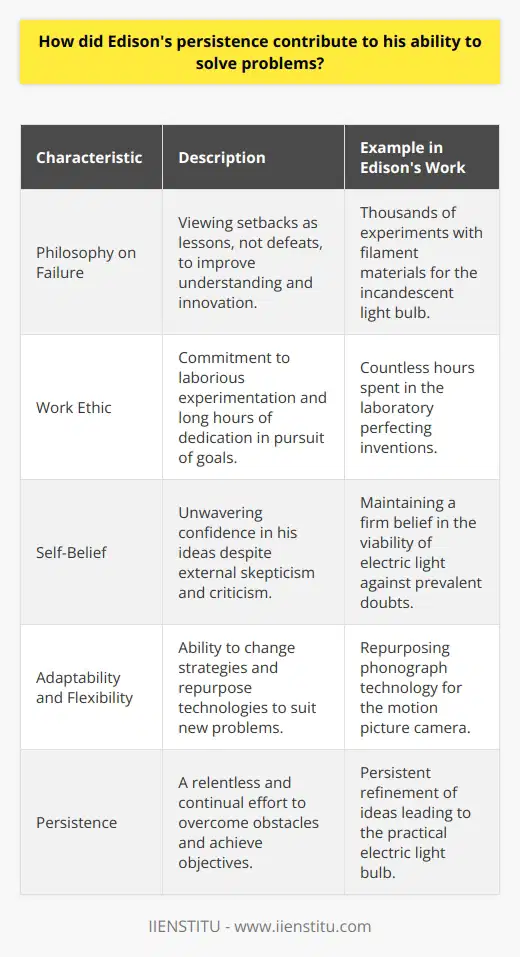
In what ways did Thomas Edison's diverse interests and experiences contribute to his problem-solving capabilities?
Diverse Interests and Curiosity
Thomas Edison's diverse interests in various fields such as mechanics, chemistry, and telegraphy played a significant role in enhancing his problem-solving capabilities. A keen observer, he continuously expanded his knowledge on multiple subjects, which later aided him in discovering novel solutions for complex issues. By investigating different domains, Edison could draw from a vast repository of information, fostering a perspective that championed innovation and creativity.
Learning through Practical Experiences
Edison's vast experience in practical experimentation significantly contributed to developing his problem-solving skills. Having little formal education, he relied on conducting hands-on experiments, which allowed him to garner firsthand experience and learn by trial and error. This empirical approach helped him understand the crucial elements of a problem and accordingly devise appropriate solutions. Additionally, the trial-and-error method promoted resilience, enabling Edison to persevere in the face of setbacks and persistently seek effective solutions.
Collaboration and Resourcefulness
Edison's ability to collaborate with experts from diverse fields further bolstered his problem-solving capabilities. By drawing on their knowledge and experience, he was able to devise innovative solutions by incorporating different perspectives. This collaborative approach also highlights Edison's resourcefulness, demonstrating his ability to leverage external resources and merge them with his own insights, thereby facilitating the creation of groundbreaking inventions.
Adaptability and Learning from Failures
A crucial aspect of Edison's problem-solving prowess was his adaptability and willingness to learn from failures. He didn't perceive failures as setbacks; instead, he regarded them as opportunities for learning and improvement. This mindset allowed him to rapidly adjust his approach and experiment with various strategies until he found the most effective solution. Edison's adaptability and continuous learning reflect his determination and commitment to overcoming obstacles in pursuit of innovation.
In conclusion, Thomas Edison's problem-solving capabilities can be attributed to his diverse interests, practical experience, collaborative efforts, and adaptability. His multifaceted approach towards learning and experimentation enabled him to tackle complex problems and generate inventive solutions, ultimately contributing to his legacy as a prolific inventor and innovator.
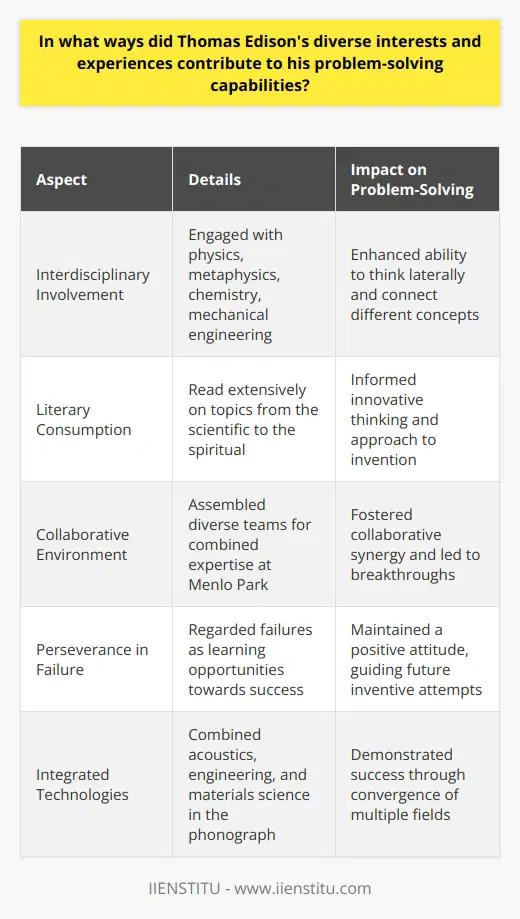
Can you provide examples of collaborative efforts in Thomas Edison's career that led to successful problem-solving outcomes?
Collaborative Projects
One of the most notable examples of collaboration in Thomas Edison's career was the development of the incandescent light bulb. Edison worked with a team of skilled researchers and engineers, including Lewis Latimer and Francis Upton, to improve the design and functionality of the light bulb. This collaboration resulted in a more efficient, longer-lasting, and commercially viable product that revolutionized the way people lived and worked.
Partnerships with Industry Leaders
In addition to his work on the light bulb, Edison also collaborated with other prominent inventors and entrepreneurs. For instance, Edison joined forces with George Westinghouse to develop and promote the use of alternating current (AC) technology for power distribution. This partnership ultimately led to the widespread adoption of AC systems and contributed to the growth of the electrical industry.
Furthermore, Edison collaborated with the renowned inventor and engineer Alexander Graham Bell in the formation of the Edison-Bell Phonograph Company. This collaboration resulted in the commercialization of sound recording and playback technology, thereby transforming the entertainment industry.
Joint Ventures in Business
Edison also engaged in several joint ventures with business partners, which led to successful problem-solving outcomes. One such example is the establishment of the Edison General Electric Company, where Edison partnered with other investors to consolidate various electric light and power companies. This venture facilitated the centralization and standardization of the electrical industry and helped drive innovation and progress.
In another instance, Edison worked together with his friend and businessman William J. Hammer to launch the Edison Storage Battery Company. This collaboration focused on refining and improving the design and production of energy storage devices. Consequently, this joint effort contributed to new advancements in battery technology and various applications, including the electric car.
In conclusion, Thomas Edison's career was filled with numerous examples of collaborative efforts that led to successful problem-solving outcomes. By working together with other inventors, engineers, and business partners, Edison was able to accelerate innovation and revolutionize multiple industries. These collaborative projects, partnerships, and joint ventures played a crucial role in Edison's success and helped shape the modern world as we know it.
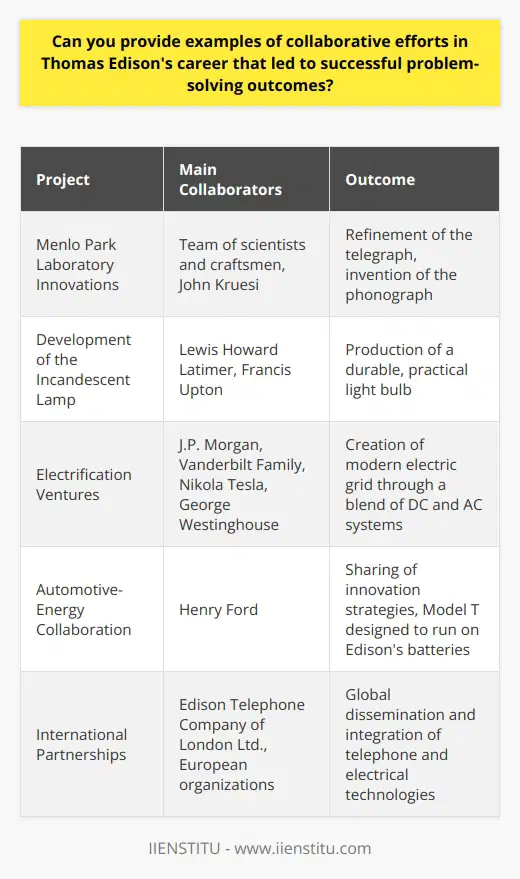
How did Edison's interdisciplinary approach enhance his problem-solving ability?
Interdisciplinary Approach in Edison's Work
Thomas Edison's ability to solve complex problems was significantly enhanced by his interdisciplinary approach to innovation. By combining knowledge and expertise from various fields, he was able to develop more effective solutions to the challenges he faced.
Diverse Knowledge Base
One of Edison's greatest strengths was his profound understanding of diverse subjects, ranging from engineering and chemistry to physics and economics. This extensive knowledge base allowed him to approach problems from multiple angles and develop novel solutions that a more specialized expert may have overlooked.
Cross-pollination of Ideas
Edison consistently drew upon ideas from seemingly unrelated fields to inform his problem-solving process. This cross-pollination of ideas often led to groundbreaking inventions, such as the creation of the phonograph, which combined principles of acoustics and mechanical engineering. By exploring the intersections of various disciplines, Edison fostered a creative environment that facilitated the discovery of innovative solutions.
Collaborative Environment
Edison's interdisciplinary approach extended to his diverse team of researchers and engineers in his famed Menlo Park laboratory. By surrounding himself with experts from various fields, he created a collaborative environment that promoted the free exchange of ideas and the development of innovative solutions. This collective intelligence approach enabled Edison's team to tackle complex problems more effectively by leveraging their combined expertise and creativity.
Iterative Problem-Solving Process
Edison's interdisciplinary approach also involved the application of an iterative problem-solving process that emphasized experimentation and rapid feedback. By continuously refining and testing his ideas, he ensured that his inventions and innovations effectively resolved the challenges at hand. This process facilitated constant improvement and the ability to adapt to new challenges—a core component of his problem-solving prowess.
In conclusion, Thomas Edison's interdisciplinary approach to problem-solving played a crucial role in his ability to develop groundbreaking inventions and innovations. By integrating knowledge from multiple disciplines, fostering a collaborative environment, and applying an iterative problem-solving process, Edison empowered himself and his team to tackle complex challenges with remarkable success. This approach continues to serve as an inspiring model for modern innovators and problem-solvers across various fields.
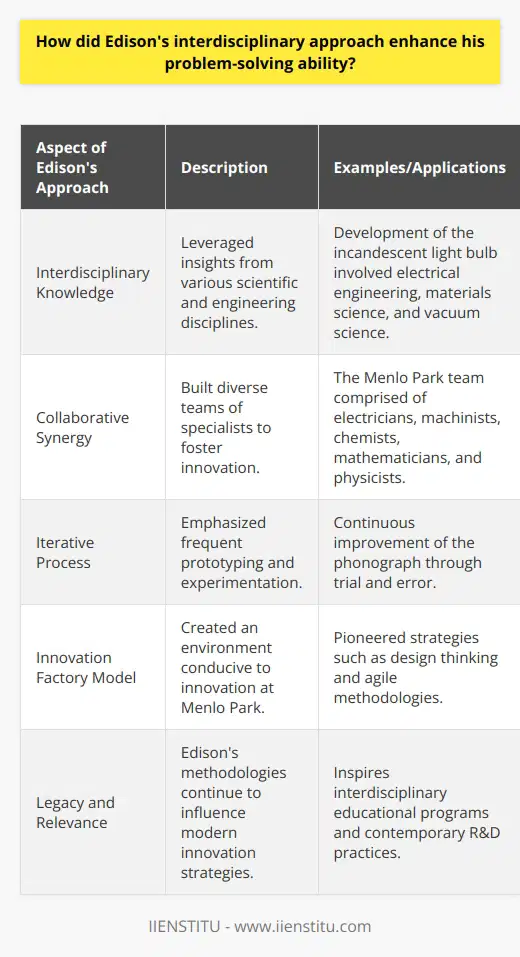
In what ways did Thomas Edison's relentless experimentation and iterative processes contribute to his successful innovations?
Understanding Edison's Experimentation
Thomas Edison's relentless experimentation played a crucial role in his successful innovations. His dedication to exploring unknown territories and fervently refining his prototypes exemplified the importance of iterative processes in achieving groundbreaking inventions.
Systematic Approach to Innovation
Edison's systematic approach to innovation enabled him to tackle complex problems methodically. He recognized the necessity of failure and learning from those mistakes, leading to successive inventions. Edison's refined a trial-and-error method by conducting thousands of tests on various materials in his pursuit of creating a practical incandescent light bulb.
Persistent Nature in Problem Solving
Edison's persistent nature in problem-solving allowed him to overcome obstacles in the invention process. He remained determined despite multiple setbacks, viewing failures as mere stepping stones to eventual success. This unwavering resilience proved to be vital in transforming his ideas into tangible realities. A famous quote attributed to the inventor exemplifies this mindset: 'I have not failed. I've just found 10,000 ways that won't work.'
Collaborative Environment
Edison recognized the power of collaboration in achieving progress, fostering a team-based atmosphere in his famous Menlo Park laboratory. He assembled a diverse group of skilled scientists, engineers, and machinists to work together in a highly-productive environment. This collaboration encouraged an ongoing exchange of ideas and expertise, further fueling the creative process.
Emphasis on Adaptation
Adaptation was an essential aspect of Edison's iterative path to innovation. He continually evolved and adapted his creations, integrating new knowledge and techniques into his projects. This flexibility allowed him to pivot willingly in response to unexpected challenges or discoveries, ultimately shaping his inventions into highly-effective, market-ready products.
In conclusion, Thomas Edison's relentless experimentation and iterative processes significantly contributed to his successful innovations. His systematic approach, persistence, adaptable nature, and emphasis on collaboration provided the essential framework for his groundbreaking achievements. By embracing failure and constantly refining his work, Edison serves as a reminder of the importance of perseverance and adaptability in the face of challenges.
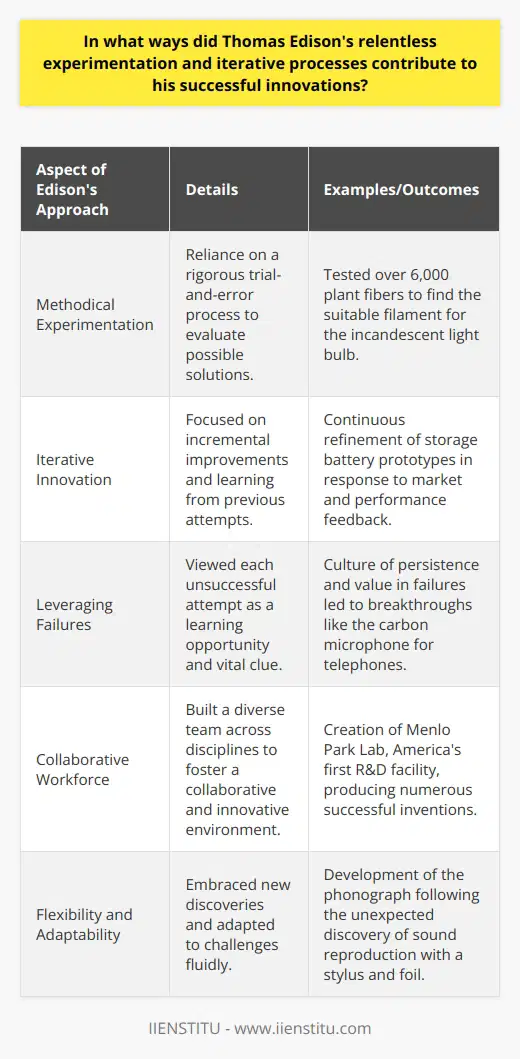
What role did Edison's ability to adapt and learn from failure play in his overall success as an inventor and problem solver?
Edison's Perseverance Through Failure
Thomas Edison's ability to adapt and learn from failure played a crucial role in his overall success as an inventor and problem solver. By continuously iterating on his ideas and learning from each trial, Edison was able to develop innovative solutions that had a profound impact on modern society.
Value of Adaptive Learning
It is essential to recognize the value of adaptive learning in Edison's success as an inventor. Edison was famously persistent in his pursuit of innovation, often attempting hundreds or thousands of experiments before ultimately arriving at a viable solution. This persistence allowed him to thoroughly analyze each failure, extracting valuable insights that informed his subsequent research efforts.
Example of the Lightbulb
An example of Edison embracing failure can be observed in his development of the incandescent lightbulb. Edison and his team tested over 3,000 different filament materials, enduring a multitude of setbacks and dead ends throughout the process. However, Edison's ability to learn from each failed experiment eventually led him to discover a viable filament made from carbonized cotton threads.
Failure as a Necessary Path
Edison's approach to failure as a necessary path to success demonstrates the importance of persistence and adaptability in achieving breakthroughs. By refusing to accept defeat and maintaining an unwavering commitment to experimentation, Edison was able to refine his inventions and ultimately create products with remarkable longevity and societal impact.
Emphasis on Growth Mindset
Edison's success in adapting and learning from failure can be attributed to his growth mindset. By viewing failure as an instructive tool, Edison was able to approach each setback with curiosity rather than frustration. This mindset encouraged Edison to ask critical questions and fostered a sense of intellectual curiosity that has become synonymous with innovation and discovery.
Conclusion
In conclusion, Thomas Edison's ability to adapt and learn from failure was instrumental in his overall success as an inventor and problem solver. Through persistence and a willingness to learn from each misstep, Edison was able to develop groundbreaking inventions that revolutionized modern society. By embracing a growth mindset and valuing adaptive learning, Edison serves as an enduring inspiration for aspiring innovators and problem solvers alike.
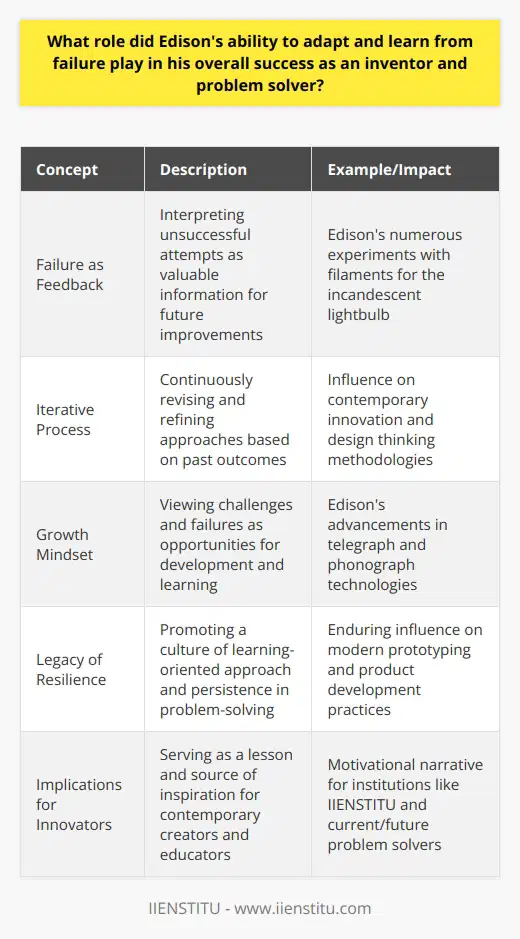
What is the success story of Thomas Edison and its relevance to modern innovation?
Success Story of Thomas Edison
The success story of Thomas Edison, the 19th-century American inventor, is a testament to his unwavering perseverance, adaptability, and passion for innovation. Edison was a prolific inventor with over a thousand patents registered to his name, including groundbreaking inventions such as the phonograph, electric light bulb, and motion picture camera. His contributions revolutionized modern technology and laid the foundation for the modern innovation process.
Role of Perseverance
Edison’s success can be attributed to his relentless determination to succeed despite numerous setbacks. Instead of being discouraged by failure, he treated them as opportunities for growth and learning. One of his famous quotes, “I have not failed, I’ve just found 10,000 ways that won’t work,” reflects his persistent resolve to continuously experiment with new ideas in search of a viable solution.
Embracing Adaptability
Edison’s ability to adapt and evolve with the changing technological landscape allowed him to stay ahead of the curve and remain competitive in the industry. For instance, when the limitations of direct current (DC) systems became apparent, Edison shifted his focus to the further advancement of alternating current (AC) systems, which are widely used today. This illustrates his openness to new ideas and willingness to alter course when necessary.
Passion for Innovation
Edison's passion for innovation was evident in his relentless pursuit of new ideas and technologies. He established the first industrial research laboratory in Menlo Park, New Jersey, where he and a team of skilled researchers worked diligently to develop countless inventions that have shaped our world. The establishment of this laboratory highlights Edison's commitment to fostering an environment of collaboration and exploration in pursuit of scientific and technological advancements.
Relevance to Modern Innovation
Edison’s legacy remains relevant to modern innovation as his approach to research, experimentation, and cross-disciplinary collaboration continues to influence current innovative practices. The importance of perseverance, adaptability, and passion for innovation demonstrated by Edison remains crucial for today's inventors and entrepreneurs. His story serves as an inspiration to those pursuing innovative solutions in various fields, emphasizing the importance of resilience, resourcefulness, and adaptability in the face of challenges.
In conclusion, Thomas Edison's success story offers valuable lessons for modern innovators. By embracing perseverance, adaptability, and passion for innovation, we can foster progress and drive societal advancements in our rapidly evolving world.
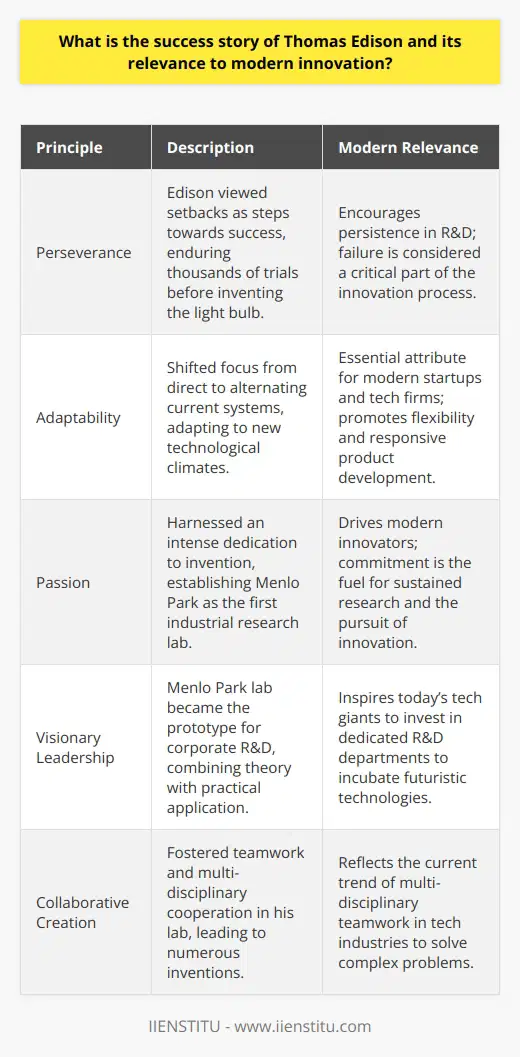
How did Edison's diverse skill set contribute to his ability to solve complex problems?
**Diverse Skill Set**
Edison's diverse skill set played a significant role in his ability to tackle complex problems. As a multifaceted individual, Edison had extensive knowledge and experience in various fields, including engineering, chemistry, telegraphy, and business. This wide range of expertise allowed him to approach problems from multiple perspectives, ensuring a more comprehensive understanding and innovative solutions.
**Strong Technical Abilities**
Having a firm grasp of technical subjects, such as electricity and mechanics, Edison could quickly analyze the components of intricate issues. His prowess in these areas facilitated in-depth examination and accurate diagnoses of challenges that arose in his research and development work. Ultimately, these technical abilities aided Edison in devising groundbreaking inventions like the electric light bulb and the phonograph.
**Creative Problem Solving**
Another crucial aspect of Edison's skill set was his capacity for creative problem solving. This inventive mindset enabled him to think beyond conventional methods and devise imaginative and novel solutions to complex problems. His dedication to experimentation and willingness to embrace failure fostered a culture of innovation, which subsequently resulted in numerous valuable discoveries and inventions.
**Business Acumen**
In addition to technical and creative skills, Edison's success can also be attributed to his keen business acumen. His ability to identify market opportunities and develop sound business strategies proved invaluable in bringing his ideas to fruition. By capitalizing on technological advancements, Edison could ensure the commercial viability of his inventions, thus transforming them into widely applicable and practical solutions.
**Effective Collaboration**
Edison's propensity for collaboration also contributed to his problem-solving capabilities. Surrounding himself with talented individuals, both technical and administrative, he built a robust team at his research facilities, such as Menlo Park and West Orange laboratories. This collaborative approach augmented the collective expertise of his team, which enabled Edison to develop groundbreaking projects and overcome formidable obstacles.
In conclusion, Edison's diverse skill set, encompassing technical prowess, creative problem solving, business acumen, and effective collaboration, was instrumental in his ability to address complicated challenges. This unique combination of skills facilitated Edison's capacity to revolutionize industries and pioneer numerous historically significant inventions, solidifying his legacy as one of history's most extraordinary innovators.
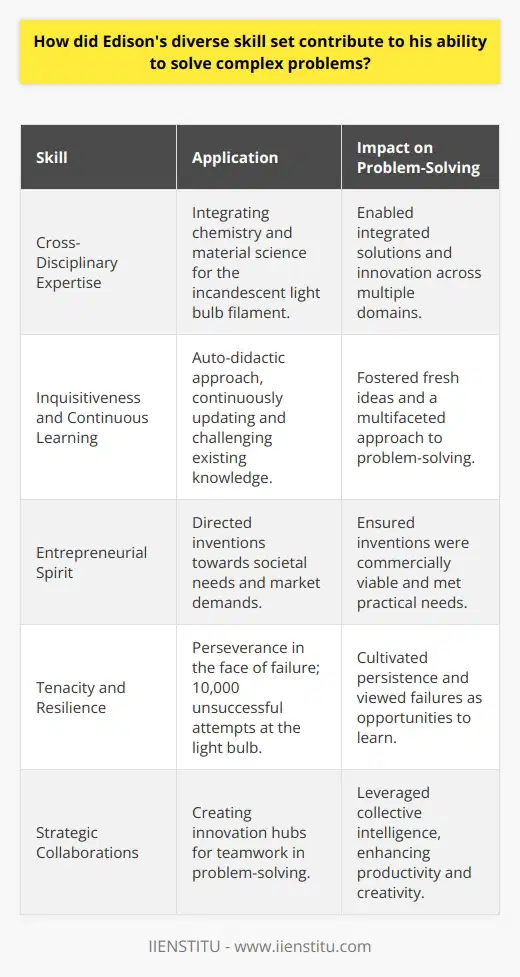
Can you discuss the role of Edison's work habits, including the number of hours he worked a day, in his success as an inventor and problem solver?
Work Habits and Success
Thomas Edison's success as an inventor and problem solver can be significantly attributed to his extraordinary work habits. He was famously known for working long hours each day, routinely clocking up 18-hour workdays, which no doubt played a crucial role in his ability to generate innovative ideas and bring them to fruition.
Propensity for Hard Work
Edison's unyielding drive and dedication to his work were essential to his success. He once stated, 'Genius is one percent inspiration and ninety-nine percent perspiration.' This belief in the value of hard work was exemplified by the sheer number of hours he dedicated daily to his pursuits. Edison's insistence on putting in long hours undoubtedly allowed him the necessary time to iterate and refine his inventions.
Focus and Persistence
Another vital aspect of Edison's work habits was his focus and persistence in tackling problems. He was known to work tirelessly on a single project for months or even years, exemplifying a nearly single-minded determination to overcome obstacles and achieve his goals. This unwavering persistence enabled Edison to overcome setbacks, learn from failures, and ultimately make breakthrough discoveries.
Collaboration and Teamwork
In addition to his own work habits, Edison was a strong proponent of collaboration and teamwork. He established dedicated research laboratories, staffed with talented personnel, working in tandem to generate ideas and develop innovative solutions. This collective approach allowed Edison to leverage the expertise and creativity of his team, further amplifying his own efforts and maximizing the outcome of his long working hours.
In conclusion, Thomas Edison's unparalleled success as an inventor and problem solver can be significantly attributed to his work habits, which included an inclination for hard work, an unwavering focus and persistence, and a commitment to fostering collaboration and teamwork. By clocking in an astounding 18-hour workdays, Edison was able to capitalize on these qualities and cement his legacy as one of the most influential inventors in history.
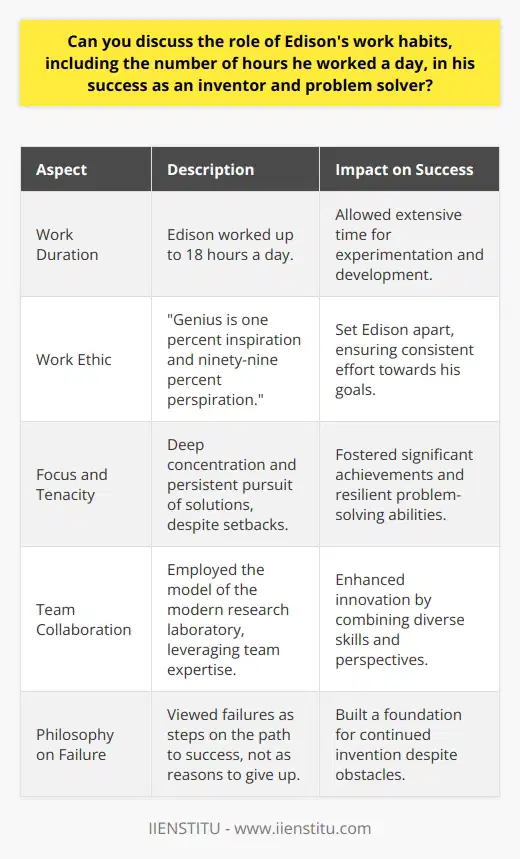
What are the nine key problem-solving skills explained?
Understanding the Nine Key Problem-Solving Skills
Identifying the Problem:
The first step in problem-solving is recognizing and defining the issue at hand, which involves understanding its root causes rather than just addressing the symptoms.
Analyzing the Problem:
Once the problem is identified, it is crucial to analyze its components, which may include breaking it down into smaller sub-problems and understanding the relationships between various factors involved.
Developing a Strategy:
Based on the analysis, a strategy needs to be devised to tackle the problem efficiently. This entails setting goals, defining actions and outlining the necessary resources.
Gathering Information:
To solve a problem effectively, it is necessary to gather relevant data and information about the problem and potential solutions to make informed decisions.
Creative Thinking:
Being able to think creatively and innovate is vital in problem-solving. It involves generating new ideas, identifying alternative solutions, and thinking critically about the chosen course of action.
Decision Making:
Choosing the most suitable solution requires evaluating the pros and cons of each option, considering the potential risks and benefits, and ultimately making a decision aligned with the goals set previously.
Implementing the Solution:
Once a decision is made, it must be put into action by implementing the chosen solution. This involves allocating resources, assigning responsibilities, and ensuring that the execution aligns with the defined strategy.
Evaluating the Results:
After the implementation, it is important to evaluate the outcome by comparing the results with the original goals and analyzing the effectiveness of the problem-solving process.
Continuous Improvement:
Lastly, problem-solving is an ongoing process that requires continuous reflection and improvement. By learning from past experiences and mistakes, individuals and organizations can become better equipped to handle future challenges effectively.
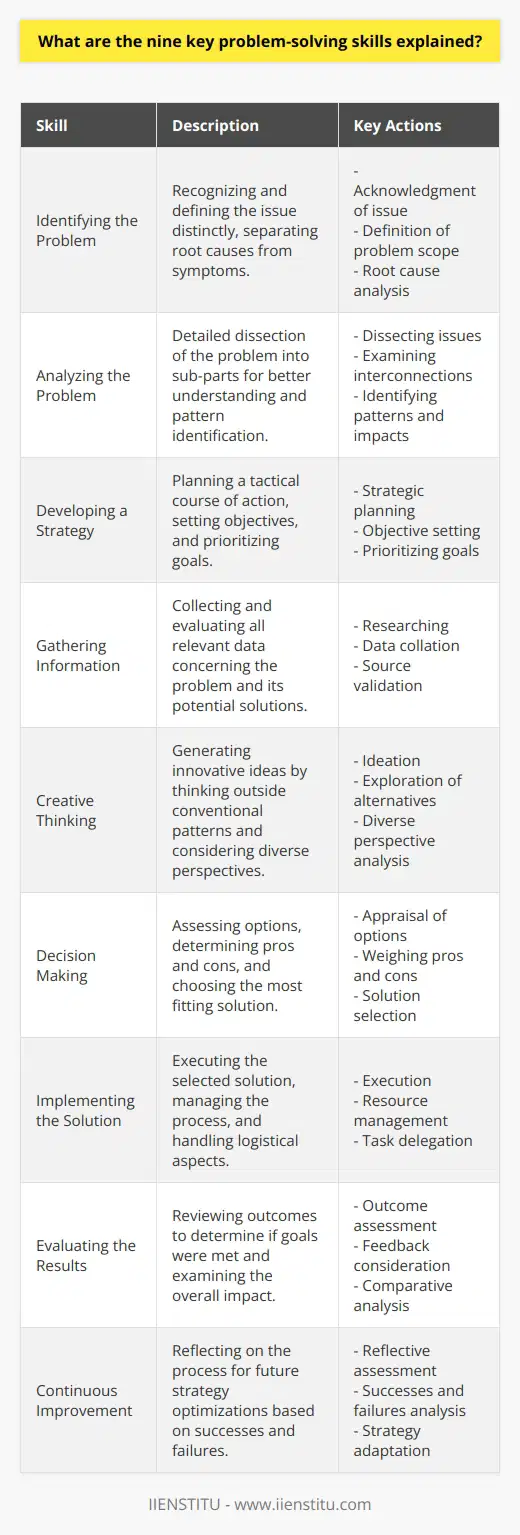
Which of the following is responsible for problem-solving skills?
Responsibility for Problem-solving Skills
Cognitive Abilities
Problem-solving skills are primarily rooted in an individual's cognitive abilities. These cognitive abilities include perceptive skills, critical thinking, and logical reasoning, which collectively contribute to an individual's capacity to identify and solve problems.
Experience and Learning
In addition to cognitive abilities, experience plays a crucial role in developing problem-solving skills. As people encounter diverse challenges throughout their lives, they learn to apply their cognitive abilities to identify patterns, draw connections, and devise strategies for overcoming obstacles.
Emotional Intelligence
Emotional intelligence, a dimension of one's ability to understand and manage emotions, also contributes to problem-solving. The ability to maintain emotional stability and cope with stress while tackling a problem is crucial in helping one stay focused, objective, and rational during the problem-solving process.
Role of Education
Education systems significantly shape the development of problem-solving skills by providing opportunities for students to be exposed to complex problems, work collaboratively, and utilize critical thinking strategies. The structure and quality of the education system can either foster or hinder the development of these important skills.
Influence of Society and Culture
Societal and cultural factors also have a role in shaping an individual's problem-solving abilities. Societal norms and cultural values can promote or discourage creativity, innovation, and critical thinking. Thus, individuals growing up in an environment that promotes an exploratory nature are more likely to develop strong problem-solving skills.
Conclusion
In conclusion, problem-solving skills are the result of a combination of factors, including cognitive abilities, experience, emotional intelligence, education, society, and culture. To cultivate these skills effectively, it is essential to foster a learning environment that encourages critical thinking, creativity, and emotional resilience, and is supported by a broader social and cultural context that values innovation and adaptability.
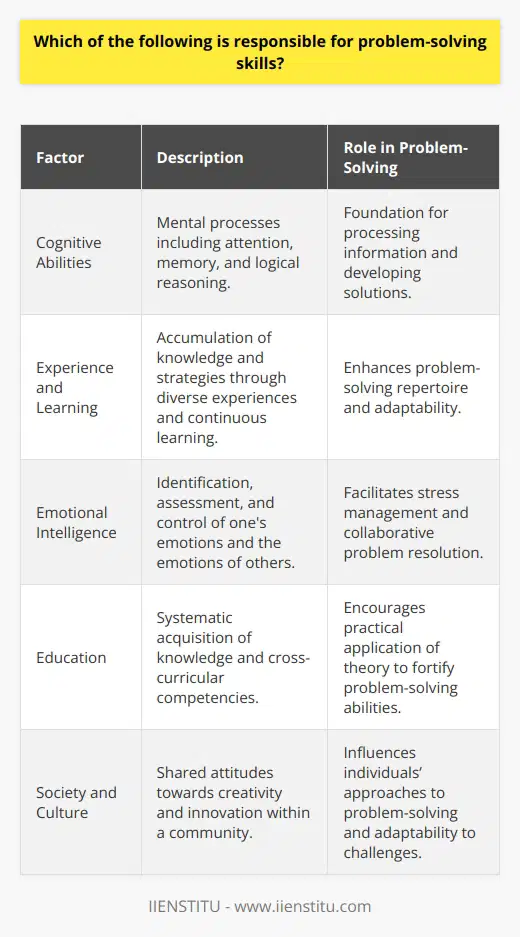
To what extent did Thomas Edison's innovative mindset influence his ability to cultivate effective problem-solving strategies?
The Innovative Mindset of Thomas Edison
Undeniably, Thomas Edison's innovative mindset significantly influenced his ability to cultivate effective problem-solving strategies. As an inventor and industrialist, Edison approached problems with resourcefulness, creativity, and persistence. His belief in learning from failures and incorporating his findings into new solutions led him to develop groundbreaking inventions, such as the incandescent light bulb and the phonograph.
Embracing Failure and Experimentation
Central to Edison's innovation strategy was his willingness to embrace failure as an opportunity for learning. By systematically logging the outcomes of his experiments, Edison could quickly deduce what methods and materials were more likely to yield success. This iterative approach, coupled with his extensive knowledge and experience, allowed him to develop effective problem-solving strategies.
The Power of Collaboration
Another aspect of Edison's innovative mindset was his recognition of the importance of collaboration. In his invention factory, Menlo Park, he gathered a team of skilled researchers and engineers, fostering an environment where ideas could be exchanged, tested, and refined collaboratively. By leveraging the combined knowledge and expertise of his team, Edison was able to create problem-solving techniques that accelerated the pace of innovation.
Systematic Approach to Problem Solving
Edison's systematic approach to problem-solving contributed to his effectiveness in generating innovative solutions. He believed in breaking down complex problems into smaller components, enabling him and his team to investigate each aspect thoroughly. This methodical approach allowed Edison to identify opportunities for innovation and improvement, leading to the development of more effective solutions.
Adapting to Technological Advances
Edison's ability to adapt to technological advances demonstrates the impact of his innovative mindset on his problem-solving strategies. By staying informed of the latest scientific and engineering advancements, Edison constantly integrated new knowledge into his work. This not only enhanced his ability to tackle increasingly complex challenges but also allowed him to anticipate the needs of the rapidly evolving industrial society.
In conclusion, Thomas Edison's innovative mindset was a driving force behind his effective problem-solving strategies. His willingness to embrace failure, focus on collaboration, systematically approach problems, and adapt to technological advances contributed to his successful career as an inventor and industrialist. Edison's influence continues to be felt today, as his creative and enterprising spirit serves as an inspiration for aspiring innovators worldwide.
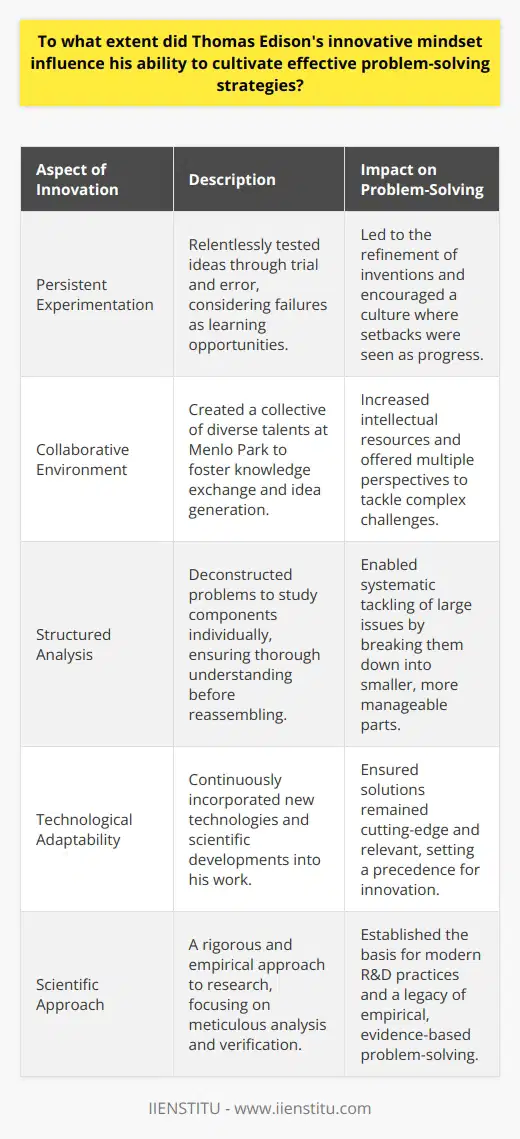
Who failed 9999 times before achieving success in their experiments?
Success After Numerous Failures
The inventor who reportedly failed 9999 times before achieving success is Thomas Alva Edison. Edison is an iconic figure in the field of innovation and invention with influential contributions that have shaped the modern world.
Persistence Amidst Failure
Edison persisted through countless trials before perfecting his inventions, which included the incandescent light bulb. Demonstrating incontrovertible patience and tenacity, he conducted approximately 10,000 failed experiments before his final success.
Trials of the Light Bulb
His most famous invention, the practical electric light bulb, was a monumental challenge. Edison iterated through innumerable configurations and materials, yet faced consistent failure. His trials were extensive, ranging from filament treatments to different types of base designs.
Overcoming Obstacles
Despite numerous setbacks, Edison did not perceive these as failures. Instead, he famously stated, 'I have not failed. I've just found 10,000 ways that won't work,' hence highlighting his resilient attitude towards failure.
Road to Success
Ultimately, Edison's dogged perseverance and optimism paid off. After thousands of trials, he finally found success, ushering in a new era with his improved version of the incandescent lightbulb. His journey underscores the important role of perseverance in the path to achievement.
In conclusion, Thomas Alva Edison's journey of inventing the incandescent bulb serves as a testament to the power of perseverance. Despite failing 9999 times, his message conveys the significance of constant effort in achieving success and rewriting history.
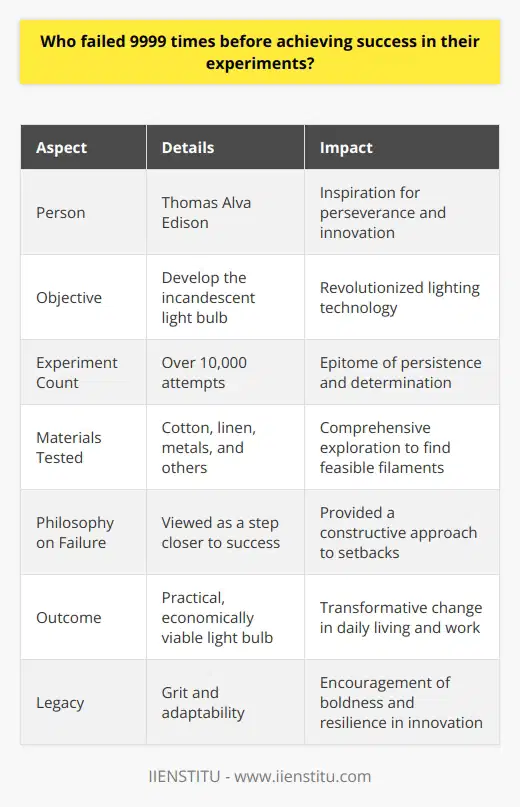
What was the key to Edison's success and how did it influence his problem-solving abilities?
Determinants of Edison's Success
The primary determinant of Thomas Edison's success was his unyielding perseverance. Edison's unwavering determination enabled him to withstand numerous instances of failures and setbacks in his path to invention. Other inventors might have succumbed to disillusionment, but not Edison. His ability to maintain perseverance amidst adversity was an essential attribute that led to his success.
Influence on Edison's Problem-solving Abilities
Edison's enlightened stubbornness had a significant influence on his problem-solving abilities. Edison adopted an iterative approach in his experiments. He learned from his mistakes rather than being discouraged by them. This unique approach transformed potential setbacks into learning opportunities, thereby enhancing his problem-solving abilities.
The Legacy of Edison's Problem-solving Approach
Edison's problem-solving tactics had a profound impact on the scientific community. The innovative method he developed offered a new perspective on the process of problem-solving, emphasizing the importance of perseverance and learning from failures. This approach is widely employed in various fields today, including engineering, medicine, and technology.
Edison's Philosophy Beyond Science
Edison's perseverance and problem-solving tactics were not just confined to his inventions. They were an integral part of his philosophy and ethos, transcending beyond his scientific endeavors and significantly contributing to his overall success. Edison's remarkable legacy serves as an inspiration to countless inventors and entrepreneurs, emphasizing the importance of perseverance, learning from mistakes, and innovative problem-solving.
Relevance of Edison's Approach Today
In today’s rapidly evolving world, the relevance of Edison's approach is more pertinent than ever. His methods encourage individuals to persevere and derive lessons from their failures rather than being overwhelmed by them, thus fostering resilience and problem-solving abilities. Edison's philosophy and approach continue to be a guiding force in the world of innovation.
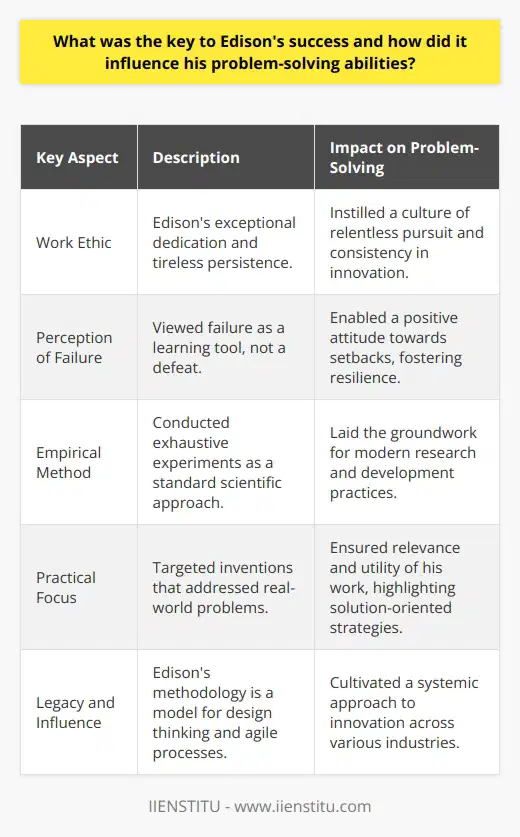
How did Thomas Edison leverage his set of skills to tackle complex problems and pave the way for modern innovation?
Understanding Edison's Problem-Solving Approach
Known for his prolific inventing streak, Thomas Edison indeed made a significant impact through his approach to problem-solving. He used a combination of deep understanding of science, ingenious thinking, and exceptional persistence to tackle thorny issues.
Utilization of Deep Technical Knowledge
Edison's deep technical knowledge served as a foundation for his problem-solving prowess. His extensive understanding of electricity, materials, and manufacturing processes enabled him to comprehend the intricacies of complex problems. Leveraging his technical insight, Edison iteratively tested and refined his inventions.
Ingenuity Brings Novel Perspectives
Secondly, his ingenuity facilitated him in addressing challenges in novel ways. He often disassembled problems to their basic elements and recombined them in innovative configurations. For instance, Edison's invention of practical electric lightbulb was not only about creating a functional device but also devising an integrated system of generation and distribution.
Persistence: Key to Overcoming Roadblocks
Furthermore, Edison possessed remarkable persistence, essential for overcoming the inherent roadblocks in any innovation process. He saw failure not as a setback but rather as an opportunity to learn and understand the problem better. This resilience enabled him to persist with experiments that others might have abandoned, such as the development of economically viable electric light bulb.
Pioneering Modern Innovation Paradigms
In conclusion, Edison's ability to leverage his technical knowledge, ingenuity, and persistence in the face of complex challenges, laid the foundation for many modern innovation paradigms. His approach to problem-solving continues to inspire scientists, engineers, and innovators across the globe, underlining his pivotal role in advancing human progress.
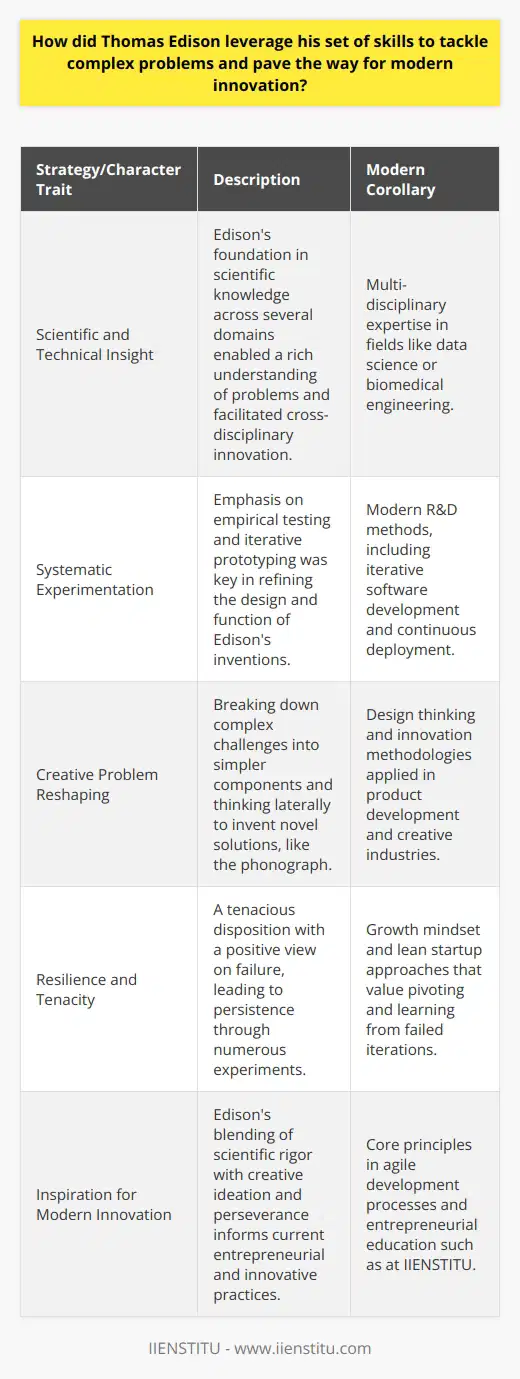
What is a problem-solving attitude and how does it contribute to an individual's success in overcoming challenges?
Understanding the Problem-Solving Attitude
A problem-solving attitude is an individual's perspective or mindset in tackling challenges. It consists of an optimistic outlook, confidence, and a proactive approach. Individuals with this attitude exhibit confidence that they can handle difficulties effectively. They believe that challenges are not permanent setbacks, but opportunities for learning and development.
The Role of Outlook
An optimistic outlook plays a pivotal role in a problem-solving attitude. By maintaining positivity, the individual can stay motivated and conquer challenges instead of succumbing to them. Optimism facilitates looking beyond the problem and searching for potential solutions instead.
Importance of Confidence
Confidence is another element of a problem-solving attitude. A confident individual is well-equipped to deal with complexities. Confidence promotes a belief in one's abilities, which in turn, leads to effective problem management.
Proactive Approach
A problem-solving attitude fosters a proactive approach. Instead of reacting to problems as they arise, proactive individuals prevent problems or diminish their impact. Proactivity thus creates an environment conducive for addressing issues efficiently.
Contribution to Success
The problem-solving attitude significantly contributes to an individual's success. It aids in overcoming challenges by encouraging new perspectives and solutions, resulting in better decision-making. Moreover, the developed confidence enables one to tackle future issues comfortably, imparting resilience. The proactive attitude further equips the individual with the skill of foresight, improving responses to prospective challenges. In essence, a problem-solving attitude cultivates qualities that foster success and progress.
In conclusion, a problem-solving attitude is a crucial asset. It is not only beneficial in overcoming current challenges, but it also prepares an individual for future hurdles. Thus, it is an indispensable part of personal and professional growth.
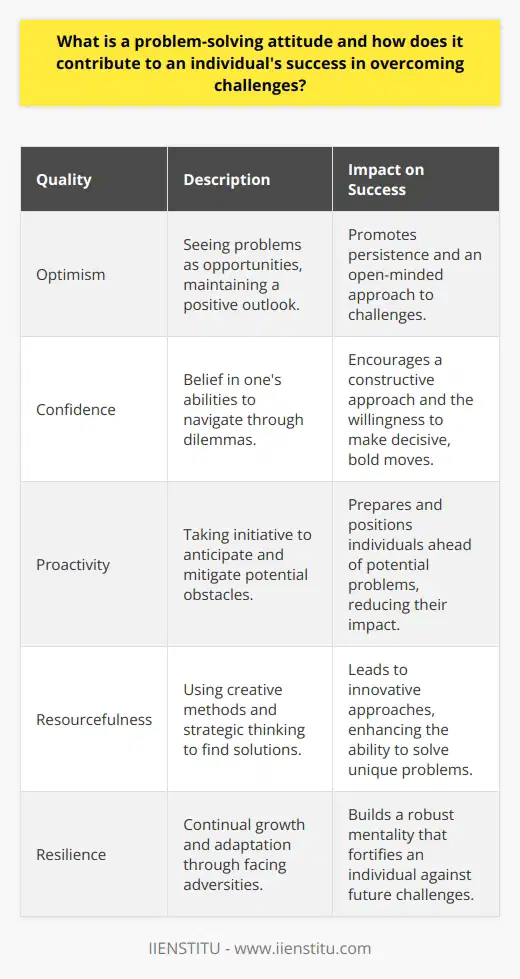
What impact did Edison's invention have on society, and how does this impact continue to be felt in contemporary society?
Revolutionizing Communication and Entertainment
Thomas Edison's invention of the Phonograph revolutionised communication and entertainment. It recorded and reproduced sounds, a novelty during the 19th century. This technology paved the way for the development of sound recording and reproduction devices, impacting film, music, and broadcast industries.
Advancement in Film and Music Industries
In the film and music industries, Edison's invention transformed silent movies into 'talkies' and enhanced the quality of sound recording, enabling more realistic performances. Today, these industries continue to benefit from his groundbreaking inventiveness.
Generation of Broadcast Industry
Moreover, Edison's craft stirred the inception of the broadcast industry, particularly radio and television. The broadcast industry thrived because the Phonograph managed to capture and replicate human voice, leading to the manifestation of radio dramas, news bulletins, and music programs.
Impact in Contemporary Culture
Edison's invention significantly influences our contemporary culture. Music, film, and television have become integral parts of our daily life. The Phonograph laid the foundation for the streaming services we enjoy today, like Spotify and Netflix.
Energy Transition
Furthermore, Edison's electric light bulb began the global energy transition, replacing candles and oil lamps. It presented a safer, cleaner, and more efficient way of illuminating homes and workplaces. Today, this advancement constitutes a significant part of worldwide electricity consumption.
Influence on Productivity
Edison's impact extends to productivity in workplaces and homes. His inventions, especially the electric light bulb, extended working hours into the night, enhancing economic productivity and transforming societal lifestyles.
In conclusion, Edison's inventiveness carved new paths in communication, entertainment, energy consumption, and workplace productivity. His inventions have imprinted an indelible mark on society, transcending over centuries, with persistent influence in our contemporary world.
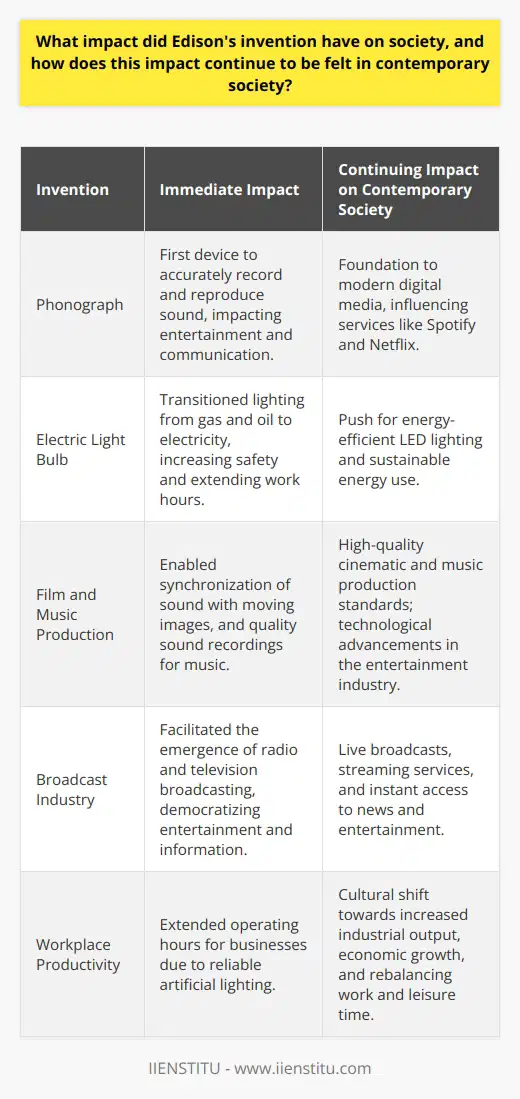
What is a positive attitude and how does it contribute to effective problem-solving in various situations?
Understanding Positive Attitude
A positive attitude involves a constructive perception towards life, challenges, and circumstances. It reflects an optimistic mindset that focuses on the good, rather than the bad, in people, events, and situations.
Impacts of a Positive Attitude on Problem-Solving
Having a positive attitude significantly impacts effective problem-solving. Because of its role in enhancing one’s perspective, it promotes adaptability and resilience during challenging scenarios. It fosters the belief that difficulties can be overcome, fostering determination and perseverance.
Positive Attitude Encourages Creativity
With a positive attitude, people often display higher levels of creativity, which play an important role in problem-solving. An open mind encourages innovative thinking for unique solutions, refuting the confinement of traditional thought processes.
Positive Attitude and Communication
Positive attitude contributes to better interpersonal communication, aiding in problem-solving contexts involving others. It facilitates open-mindedness for effective communication and cooperation, enabling collective efforts towards resolution.
Positive Attitude Building Resilience
Lastly, a positive attitude can build resilience, leading to effective problem-solving. It helps individuals withstand adversities and bounce back from failures, which is important in managing multiple or severe challenges. By carrying the belief of potential success, people become ready to tackle problems head on.
In conclusion, a positive attitude is an optimistic approach towards life that greatly influences problem-solving. It encourages creativity, fosters effective communication, and builds resilience. All these components collectively contribute to effective problem-solving in different situations.
